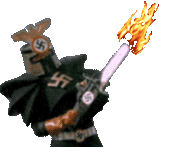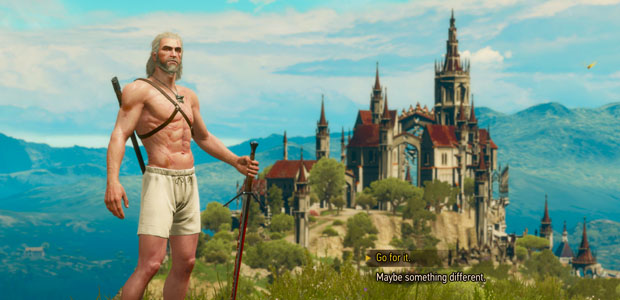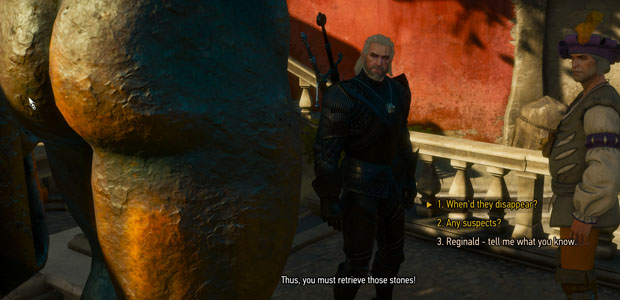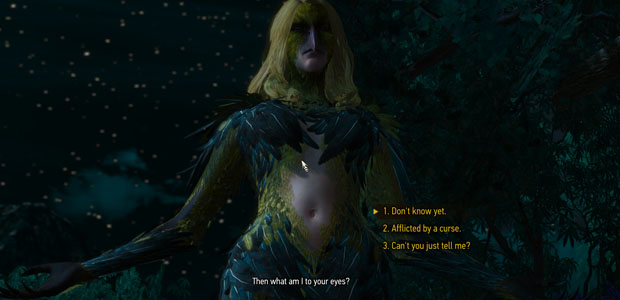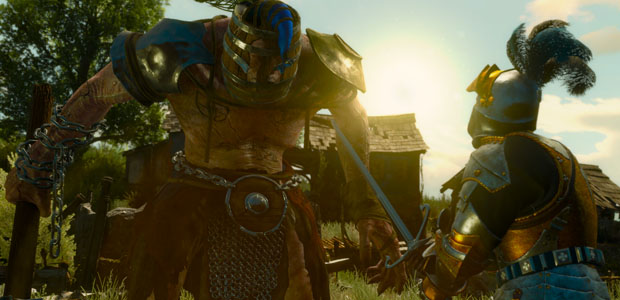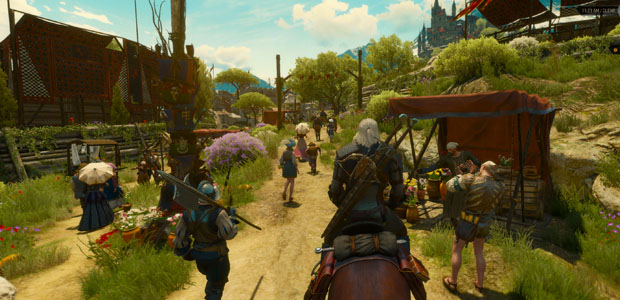Wot I Think: The Witcher 3: Blood And Wine
Richard Cobbett on May 25th, 2016 at 2:00 pm.
The Witcher 3: Wild Hunt [official site] is one of the best RPGs ever made, and the first DLC, Hearts of Stone, certainly didn’t let the side down. Now, Geralt’s final adventure comes to an end in a terrorised land. Is it a fitting finale? Here’s Wot I Think.
There’s always been an element of finality to The Witcher. Geralt is a man out of time, figuratively, but increasingly aware that the end isn’t going to be far off. At some point he won’t be strong enough to ply his trade. At some point, he’ll be just a little too slow to dodge out of the way of the incoming griffin, and his reward for a lifetime of heroism, compassion and saving the world will be a painful, lonely, and likely little-mourned death on some cold hill somewhere. Mostly, he seems okay with that. But CD Projekt RED, which has ridden this series from obscurity to the top-tier of RPG developers, clearly aren’t. Blood And Wine is their parting gift – not to us, but to Geralt himself. A big ‘thank you’ present wrapped in a bow and slipped with love between universes.
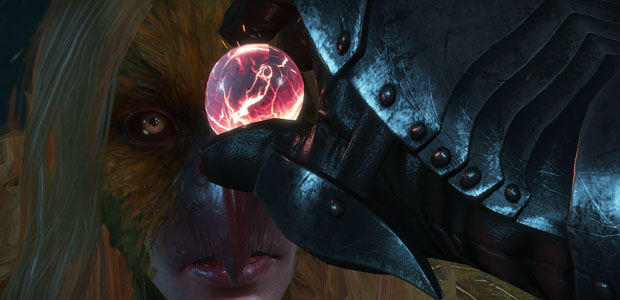
Of course, it’s also another huge DLC pack full of everything that The Witcher III does so well, including offering the power to surprise. The mechanics are well-worn now, there aren’t really any changes to the core systems, and I could happily go a year or so without the words “Use your Witcher senses to-” trying to burn their way into my screen. In terms of quest design though, it’s surprises around every corner, from dealing with a wight with a spoon obsession to trying to track down a statue’s magical testicles. I’d love to see some of the stuff that CDP has rejected over the years for being too silly or time consuming, because as ever, they’re all implemented with the kind of love most RPGs restrict to their big critical path set-pieces.
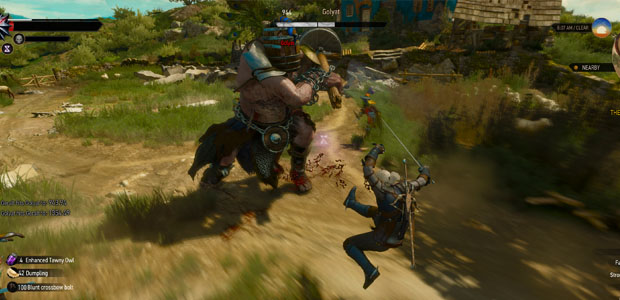
In raw terms, I finished this DLC in about 15 hours, but that’s not even close to a complete run. There’s a whole new map full of points of interest, treasure troves, Witcher contracts and more, and I still had great swathes of map left unexplored. As with Hearts of Stone, you can continue your existing save into Blood and Wine, or be given a brand new Geralt at Level 35 to customise with what you want. Other smaller additions include dyes that can be used to customise Witcher gear, a new Skellige Gwent deck, and a tweak to the mutation system that I unfortunately wasn’t able to try due to a bug – not being able to slide down a rope into the new area and get the gear. The gist though is that you can unlock new mutations that do more than just boost damage, like freezing people with Aard or landing critical hits with other signs.
The story is standalone, but you’ll want to have finished the main game. There aren’t any truly bastard-hard enemies like the Caretaker from Hearts of Stone, though the final one gives it a good shot, but Geralt does have to handle some seriously big brawls. I said ‘brawls’. Though that said, this is a Witcher game…
Unlike the last DLC, Hearts of Stone, Blood and Wine also takes place in a brand new region – Toussaint. Unlike most of The Witcher series so far, it’s an idyllic place untouched by war or even that many problems. Knights ride around in search of adventure or glorious battles to win the hearts of their lady-loves, peasants go mostly unmolested by soldiers or invaders, and most people are said to be slightly drunk all the time. Which would explain some of the dodgy, not-quite-French accents.
Of course, that’s during the day. At night… ah… well, actually, at night things are pretty much the same. Almost creepily so. I was expecting the place to be on the lines of Mordavia from Quest For Glory IV, where beautiful days give way to terrifying nights and the people hide in terror of vampires and their minions. Instead, while there are monsters like everywhere else in the Witcher universe, relatively speaking it’s a place with few concerns and no real reason to be afraid of the dark. Heck, this is a holiday destination. Geralt even spends most of the adventure teamed up with an old friend who happens to
be a higher vampire (not a spoiler, he’s completely open about it), and one of the most sociable and pleasant companions a Witcher could have.
On top of that, Geralt has never been so warmly welcomed on a contract. The Duchess is an old friend, most of the citizens aren’t particularly bothered about having a Witcher in their ranks, there isn’t the constantly hanging prejudice towards non-humans, and where he goes, he’s typically and openly given the respect of titles like ‘master witcher’ and thanked for his efforts instead of paid a pittance and told to piss off.
The result has an odd flavour to it. In and of itself, Toussaint isn’t that exciting a location. Oh, don’t take that as too big of a criticism. It’s a gorgeous, intricately designed place. The palaces and streets of its main city, Beauclair, are wonderful, and there’s some fantastically dark and beautiful stuff later on that I’m not going to spoil, but would advocate kneecapping anyone who does. However, for the most part it’s not
that different to the scenery we’ve now spent so long riding around in The Witcher III, and I wouldn’t have minded a trip somewhere a little further afield to see something other than fields and grasslands and European city designs, even if Toussaint’s are more French. I kept waiting for it to reveal some dark and twisted side, but it simply doesn’t, give or take a little dickishness from some of its less chivalric knights.
But as I said at the start, that’s not what Blood and Wine is about, not really. It’s a story about a man who has already
had his last big adventure, and is more interested in giving him something hitherto impossible – a place to happily retire, if he chooses. Brick for brick, Toussaint is Geralt’s perfect resting place – wine, women, respect, beasts for if he gets bored, and the political stability to be able to just sit back and let the world worry about itself for a while. CD Projekt even gives him… and I think ‘him’ rather than ‘the player’ is more apt… a vineyard, complete with staff and loyal majordomo (I won’t spoil his name, but
ouch, guys,
ouch) and you have to love his cautious excitement at the idea of finally having owning a comfy bed and at least having the choice to hang up his swords. Whether or not he does is just detail.
Mechanically though, the vineyard doesn’t offer a lot. You repair it with the loose change in Geralt’s pocket at this point in the adventure and then it more or less just sits there, offering an alchemist’s table, useful tools like a grindstone and herb garden and a bed with a vitality buff, and a touchpoint for a couple of stories. You don’t really run it, and can’t customise it very much, except hanging a few paintings on the wall and loading up weapons, armour and trophy stands with the spoils of past adventure. Its role in the story makes it more than a token gesture, with a couple of touching scenes, but it’s a gold sink rather than a home, right down to the people working there just having generic peasant barks instead of acknowledging that you’re their boss. It’s fine. Just don’t expect much, and certainly not a Stardew Valley type thing.
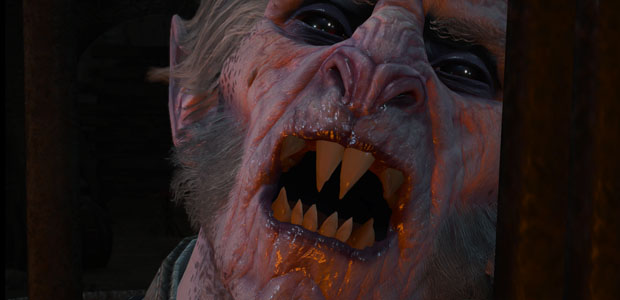
None of this however has anything to do with the main plot, so don’t worry that this is spoilerville. It’s really not. The actual plot is however hard to talk about in detail
withoutruining things, because it wouldn’t be The Witcher if “Come to our land and kill a monster” wasn’t as twisty and turny as a maze of tiny passages, all alike. Making it harder is that I liked it a lot more when it was over than during most of its run, largely due to some very odd pacing decisions and time-jumps and moments where key plot elements seemed to have been forgotten, only to return five hours later with the kind of dramatic “Oh yeah!” normally reserved for the Kool-Aid Man.
It’s not CD Projekt’s best work, but it’s worthy enough. It’s good story, a well told story, but simply nowhere near the excellent craft of Hearts of Stone, which used the increased space but tighter focus of its DLC for a character piece. Here, a relatively basic plot is padded out to the point of losing much of its power, with what’s left typically pulling its punches. In the opening couple of hours for instance, the Beast of Beauclair that you’re sent to take out racks up one hell of a body-count, with the story then having to justify… poorly… why Geralt can then spend the next 10 hours riding around on Roach and doing odd-jobs for people. Later, there’s just no getting past the problem that when things go wrong, it’s usually because characters have been ridiculously obstinate or refused to just talk things out, with no option as Geralt to clang their stupid heads together instead of waiting around for the next big plot twist.
But, that said, its big moments hit some impressive highs, especially one that dives full-on into fairy-tale instead of just borrowing from them, and character moments that spread sympathy and character development thickly. There’s a certain element of Once Upon A Time to it in terms of exploring the origin of evil, though thankfully that’s where the comparison ends with that ridiculous show that I still somehow keep watching only to scream at. The Witcher is always at its best when decisions aren’t easy and killing a monster has a sense of tragedy to it. Blood and Wine respects that, whether it’s in Geralt’s look of sheer disgust at knights crippling a monster just for a showy battle in the arena, or his willingness to put life and dignity on the line to help someone break a curse instead. Even more than usual, breaking out the silver sword feels like a failure.
It’s fitting that while his adventure in Toussaint isn’t the most exciting, risky or honestly even important part of his life, it’s a place where his acts of kindness and compassion are finally recognised. Occasionally to the point that I had to check that this was still a Witcher game, yes, especially when a divine entity apparently steps in from a bit of fan-fiction to confirm that yes, he is objectively a Good Person. Never however to the point that I begrudged Geralt finally being somewhere he could finally make a life.
Had Blood and Wine been the
first expansion, I think it would have left me slightly cold. That’s cold by CD Projekt RED standards though, so nothing to be ashamed of. It would still have been 15+ hours of funny quests, gorgeous scenery, surprises and moments of both chilling darkness and wonderful warmth. It just doesn’t have the same grit as the main game, and the first DLC needed the overhanging threat of someone like Master Mirrors to compensate for the lack of the Wild Hunt. As a finale though, it does everything it needs and made the right choices. CD Projekt has talked about doing more Witcher games at some point, but with Witcher III being the end of Geralt’s story. There isn’t really anywhere to go with it now. With Ciri, he’s passed the torch or given up the chance to. In Hearts of Stone, he faced the greatest enemy he realistically can – the devil, the ultimate monster who can never be beaten in a fight, save one of wits.
Nothing that follows has any chance of living up to those moments, and never mind the fact that he started the series dead. What can top that? Only an
ending.
Much like Mass Effect III’s wonderful Citadel expansion, this last outing is as much a victory lap, to remind us of the good times and end in the right spirit. There’s a moment in both games, where the characters seem to step out of themselves, just briefly – Shepard to look at the Normandy and state that it’s been one hell of a ride, even if chronologically she hasn’t fought the final boss yet. She’s talking to her crew, and we’re included because we’re part of it. In Blood and Wine, it’s a more understated moment. A simple glance through the screen from an old man who’s literally seen everything – a look of respect, of gratitude, of recognition. Something ends, something begins.
I like to think that it’ll be happier than most of what’s come before.
The Witcher III: Blood and Wine is due out on May 31st. It requires the base game.















